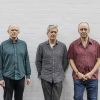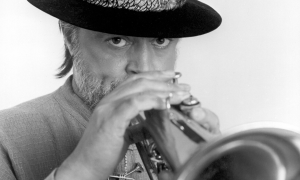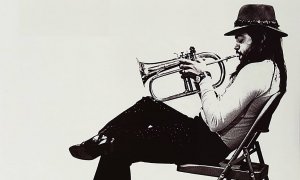Home » Jazz Articles » Catching Up With » Lloyd Swanton: The Necks Trust Each Other to Not Push th...
Lloyd Swanton: The Necks Trust Each Other to Not Push the Music Too Fast

All About Jazz: How would you characterize the unique aspects of The Necks?
Lloyd Swanton: I think whatever is really unique about us all stems from our decision when we first got together, that we were only ever going to play in private. Obviously we broke that undertaking! But I think, while it was in place, it allowed us to form our method of music-making completely free of any outside pressure, and nearly 30 years later we're still operating under the same principles.
AAJ: band has been active for 30 years and so far it has released 17 records. What is unique about the creative partnership the band members share? Can you talk about the collaborative process that enabled this music to happen?
LS: I don't play this way with any other musicians. (And that is as it should be!) I can't speak for myself, but I believe Chris and Tony are both utterly unique voices on their particular instruments. So, we have three distinct voices, and we have complete trust in each other, and in our method of improvising. We always try to find the positive in every texture we collectively generate; to not be judgmental. We all trust each other to not push the music too fast, or into places that it doesn't want to go. We know to stand back from the music and let it show us where it's heading.
AAJ: How has the band's chemistry evolved since the band's debut Sex up to the last Open?
LS: It is impossible to put into words, but it is very clear to hear. Again, that is as it should be. I would be very concerned if we still sounded the same after 30 years! But having said that, I feel there is still something linking the 1987 Necks with the 2014 version.
AAJ: The core of the band's playing successfully balances between jazz and ambient influences. Can you describe how you negotiate between jazz sounds, improv, and the delicate ambiences that the band manages to create?
LS: Again, not something that is easily expressed in words, but I can say that the three of us all listen, not just to jazz and ambient, but to a huge range of music, and of those various musics we form our own thoughts about what we wish to bring to The Necks' music. We don't ever discuss it with each other, but it's understood that anything we've been listening to or been working on may be offered up next time we get together to play.
AAJ: Your records feature long compositions, often a single composition that stretches over the record. How did this concept arise?
LS: Once we'd made the discovery about learning not to push a piece too urgently, we quickly found that we needed an hour or so to toss a few ideas around, find some things we liked in a few of them, maybe go off down a few dead-end paths, get the piece up in the air and really flying, and then bring it back down to land. That's for our live improvisations, at least, but it carried over to our studio albums, and the CD format had arrived just in time for us. Although we've recently done an LP with two 20 minute pieces on it, in the early days I don't think we could have fully expressed what is unique about our music in 20 or so minutes, and it would have been tragic to cut a piece in half to fit it across both sides of an LP, so the CD format was just what we needed.
AAJ: The Necks are known for their improvisatory skills. What do improvisation and composition mean to you and what, to you, are their respective merits? How strictly do you separate improvising and composing?
LS: They are simply two different, but related ways of generating music. Improvising can be seen as a composition in real time, usually in a public situation, or can be a way of generating material in private, for a more formal composition, and on the other hand composition of course can be a springboard for improvisation, most obviously in jazz. Improvisation is so very natural to me; it's hard to imagine what it's like for musicians who aren't comfortable improvising.
AAJ: The band had a rare opportunity to jam with Brian Eno at the festival he curated in Sydney, Pure Scenius? What was that experience like?
LS: Just fantastic. He's such a legend, and although I don't think his music was a particularly direct influence on us, there is simply no way we could have begun thinking along the lines we have with The Necks without Brian's precedent. He is truly a pioneer and we owe a lot to him. And a very collaborative, consultative and inclusive leader. He had a "game plan" for our performances with Pure Scenius, but was absolutely interested in hearing our suggestions and took a lot on board and worked it into the process.
AAJ: What constitutes a good live performance in your opinion? What's your approach to performing on stage?
LS: We have learned to not get too hung up on any one performance, good or bad, but having said that, I think we feel a good performance is one where we tried to do a few nice things and they worked without being forced, and a few surprises came along as an extra reward for our success!
AAJ: How does the soundtrack work on The Boys compare to your other work?
LS: I think the way that music came about means that that album sounds a little different to the others. We provided the filmmakers with a lot of rough-mixed textures for them to work with however they wanted, and it was only after we'd provided them with all of that and finished that part of the process, that our thoughts turned to making an album.
AAJ: What are some musical contexts that remain unexplored by the band?
LS: There's only one way for us to find that out, and that is to keep exploring!
Selected Discography
The Necks, Sex (Fish of Milk, 1989)
The Necks, Aether (Fish of Milk, 2001)
The Necks, Open (Fish of Milk, 2013)
Photo Credit
Courtesy of The Necks
Tags
The Necks
Catching Up With
Nenad Georgievski
Australia
Tony Buck
Lloyd Swanton
Chris Abrahams
Brian Eno
About The Necks
Instrument: Band / ensemble / orchestra
PREVIOUS / NEXT
Support All About Jazz
 All About Jazz has been a pillar of jazz since 1995, championing it as an art form and, more importantly, supporting the musicians who make it. Our enduring commitment has made "AAJ" one of the most culturally important websites of its kind, read by hundreds of thousands of fans, musicians and industry figures every month.
All About Jazz has been a pillar of jazz since 1995, championing it as an art form and, more importantly, supporting the musicians who make it. Our enduring commitment has made "AAJ" one of the most culturally important websites of its kind, read by hundreds of thousands of fans, musicians and industry figures every month.





















